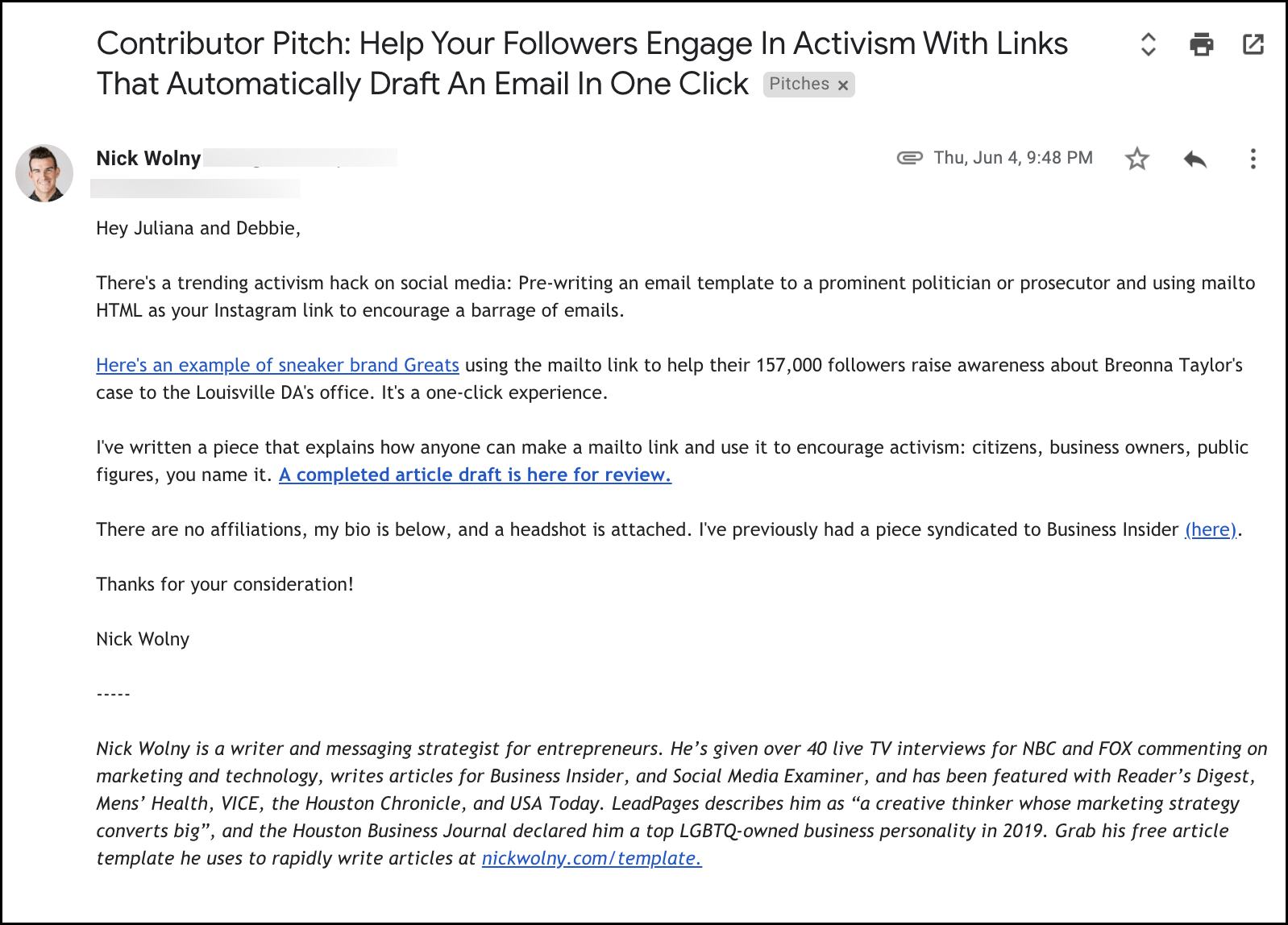HOW TO WRITE FOR BUSINESS INSIDER AND GET PUBLISHED IN 36 HOURS FLAT

Wondering how to write for Business Insider or other big publications? Would the chance to get your expertise in front of hundreds, thousands, or millions of people for free help you reach your goals?
Writing a contributed article for a traditional media outlet will give you these results, and these days you no longer need a publicist to start securing placements.
I know this works, because as recently as last year I was helping clients secure articles in outlets like CNBC, Forbes, and Entrepreneur at my old PR agency job.
- I would ghostwrite a viable article draft,
- The client would review and edit for accuracy and voice, and then
- We would pitch completed articles to prospective editors.
It was great. But ghostwriting has a way of hollowing you out after a while; you see your words getting results and praise for other people, and you sometimes wish that effort would have been invested in yourself instead. Now I help other people write articles and get them secured in publications all by themselves.
So it was nice to know I’ve still got it (Even when I’m writing as myself, a quiet gay dude in Texas, and not as a millionaire business tycoon or an inspirational yoga guru) with a recent full article in Business Insider, which was then syndicated to over twenty other outlets. Here’s how I did it.

How to write for Business Insider: My exact pitch
This article was completed and pitched on a Thursday night, accepted on a Friday morning, and published on a Saturday morning.
One reason I cracked how to write for Business Insider and was fast-tracked was that my draft was already written, I picked a very timely topic, I did my homework, and I made it as easy as possible to cut down on the back and forth with prospective editors.
No secrets here, y’all — this is the exact pitch email I sent.

This pitch seems fairly innocent, but actually has strategy and research laced in at various points. It’s important to make your pitch custom, thoughtful, and unique; a person on the other side is wading through dozens or even hundreds of pitches each day. Let’s pick apart the steps taken to maximize chances for success.
Step 1: Research what the outlet is looking for
Read my lips: Most media outlets actually want you to pitch them. If they don’t, they’ll say so; otherwise, assume the outlet is taking queries.
Some outlets are traditional media publications and have the advantage of being a household name. Other outlets are niche websites that cater to a specific, unique audience. Psychiatrists have Mad In America, online business people have Smart Passive Income, et cetera. It’s important to take a moment and ask yourself who you really want to be in front of.
In many cases, the outlet gives you instructions on a silver platter on exactly how to pitch them. This is the case for Business Insider and many others. Your best practice is to look for a contact page or a “Write For Us” page on their website. Here is what the Write For Us page for Business Insider looks like.

It also helps to spend some time looking at what’s getting published now for a particular outlet. Are some of the articles responding to current events? Are there particular topics being covered repeatedly? These are clues that can give you information on what to write about.
You could write the next Moby Dick, but if you aren’t delivered what the outlet is asking for in the way they’re asking for it, you’ll be rejected or flat-out ignored.
Step 2: Write a killer article
I know, I know – this is a pretty big step two and is easier said than done. That’s why it’s good to invest in yourself and hone your writing skills regularly and consistently. More and more outlets that publish contributor and opinion articles now want to see an already-written article draft and a strong headline included in your pitch.
In its simplest form, I follow a three-draft approach to producing articles.
- My first draft is a free-write, a race to get to a thousand words as quick as I can, and usually a steaming pile of garbage.
- My second draft is a series of surgeries in which I commit to combing through my freewritten mess sentence by sentence to sharpen my position, and
- My third draft is more about polish, word choice, and rhythm.
Each draft feels very different. It’s important to practice all three drafts and identify which draft stage you’re in as you write. Otherwise, you’ll have a hard time establishing a regular routine.
Step 3: Make it as easy as possible to say yes
It’s time to pitch! I like to include everything an editor or gatekeeper might need or want in order to publish the article immediately. This cuts down on back-and-forth emails, which can actually be the difference between your article getting published or getting lost in the mix.
Include the following information:
A headshot and short bio
Don’t ever make an editor have to ask you this question; they have a zillion email threads already that they’re managing. Attach a high-quality headshot (But not a file so large it obliterates their inbox) and a media bio. Check to see what the bios look like for other contributors on the site. For Entrepreneur, for example, I’m allowed up to 200 words, but for Social Media Examiner I only get 30 words.
Past published writing samples
If you have past samples of published work, throw in a humble brag. This lets the editor know before they click to read your draft that your writing has been published before by other editors.
Confirm any affiliations
You have to disclose any financial relationships you have with cited experts or resources in your articles. Unfortunately, the last few years have seen a rise in contributors selling their platforms. Confirm from the get-go that you have no financial ties to the materials in the article.
—–
The few articles you pitch will take some practice. But over time, as you become accustomed to every step of the process, you’ll find yourself writing more, pursuing big outlets, and securing name recognition that can build up your brand over and over again.

